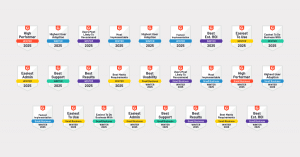The use of a work breakdown structure (WBS) is synonymous with project management in the built environment industry. Paul Hemmings, head of product at AEC business and project management software firm, Total Synergy, says, “everybody in the industry needs to use a work breakdown structure — it’s just a matter of how well they do it”.
So, what is a WBS, and why should you use one to maximise your project management success?
In the most basic terms, a WBS divides, and then sub-divides your projects into measurable, manageable increments. It’s a project management tool that sets out everything a project is contracted to accomplish. The WBS then splits those contracted items into multiple levels and displays these elements graphically – in some sort of tree-structure diagram or table. This results in a detailed project plan of the deliverables you must turn over to finish the job.
Total Synergy’s business development manager, Julian Connolly, says, “it’s like the question of ‘how do you eat an elephant?’ … the answer is ‘one bite at a time’, and with the WBS you’re taking an elephant-sized lump of work and breaking it down into more consumable pieces — in our case, it’s phases, stages, and tasks.”
The WBS effectively provides a common framework for the planning and management of your projects. Significantly, that means better control of your projects as they progress, which allows opportunity for corrective action if things don’t turn out exactly as planned.
“The stages and their smaller parts allow you to make corrections because you’ve got the project segmented” says Julian. “If you find you’ve choked on concept design, that can then shape your approach to schematic design, detail design, and contract documentation, for example.”
To create and utilise your WBS effectively, it’s important to be clear on the four key principles that govern it.
The 4 key principles of a work breakdown structure
1. Hierarchy
A work breakdown structure relies on the hierarchical presentation of its items. That means every ‘child’, or ‘branch’ item is a sub-item to its parent task, and when all the child elements are added up, they create a sharp picture of their parent task.
2. The 100% rule
A successful WBS always abides by the 100% rule, which is that each level of the structure must add up to 100% of the parent level. No more, and no less. It also requires that every parent level must have at least two child elements.
3. Mutually exclusive elements
To avoid duplication of work and the possibility of miscommunication, a WBS requires that every element at each level be mutually exclusive — with no overlap between each deliverable or package of work.
4. Outcome (not action) orientation
Due to its nature as a deliverable-oriented system of project management, the illustration of the WBS must focus on the outcomes (or results) rather than the actions required to produce them. This also builds flexibility into the structure of the system, allowing creativity and ingenuity on the part of individuals when deciding how they’ll execute a given task.
On top of this, a good, AEC industry-specific business and project management software will link your WBS with invoicing and budgets — so that you can remain aware of, and show clients, your progress through work, time, and payments associated with the project.


